I have used this little Leica for a couple of years having bought it 2nd hand during the Lock-downs. The original lens was the Elmar 5cm f3.5, the type that sits inside the camera body and you pull out when taking photographs. This lens was not terrible, but lacked the contrast I expect from a Leica camera and, having read about photographers from back in the day who substituted it for a Canon lens, I decided to do the same. This is now the lens that I use, with better results, in my opinion. I decided to use Kentmere film simply to try it out and was surprised at the result in a number of ways.
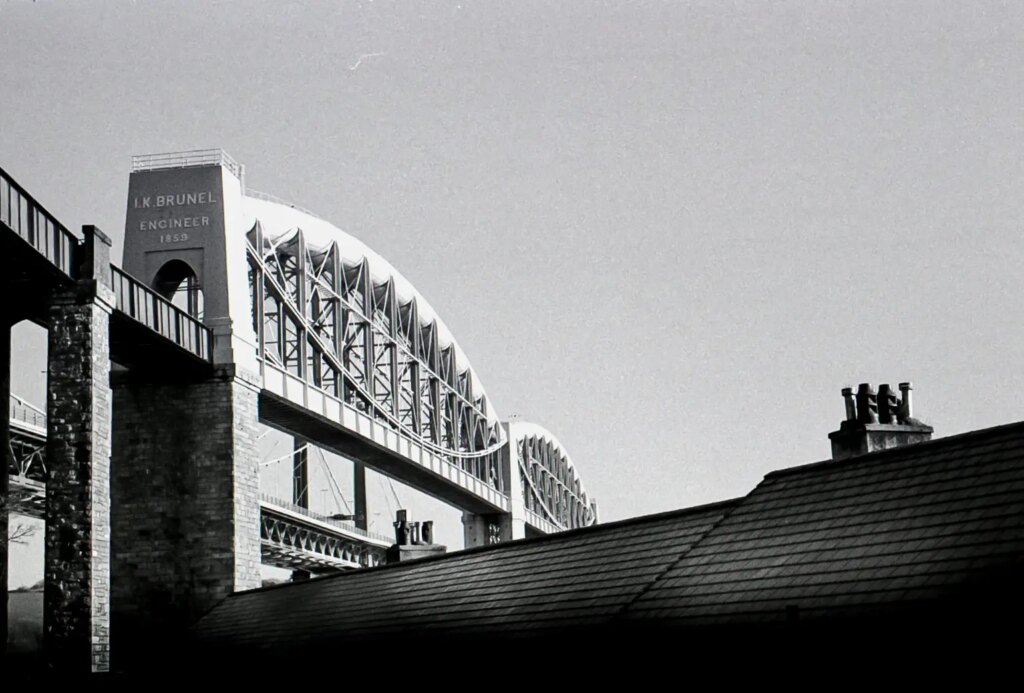
I went out on a remarkably sunny day, a welcome break from all the rain we have been having in the West Country, walking over the Tamar bridge out of Plymouth and down into Saltash and the county of Cornwall. The sunshine made for a high contrast environment and I was interested to see how the Kentmere film would perform; it is not known for particularly great contrast, although I found that the contrast was generally quite good. Additionally, I saw that the film has very good exposure latitude and where I would, ordinarily, expect heavy shadow, I found good shadow detail with no loss of highlights and a very good level of sharpness.
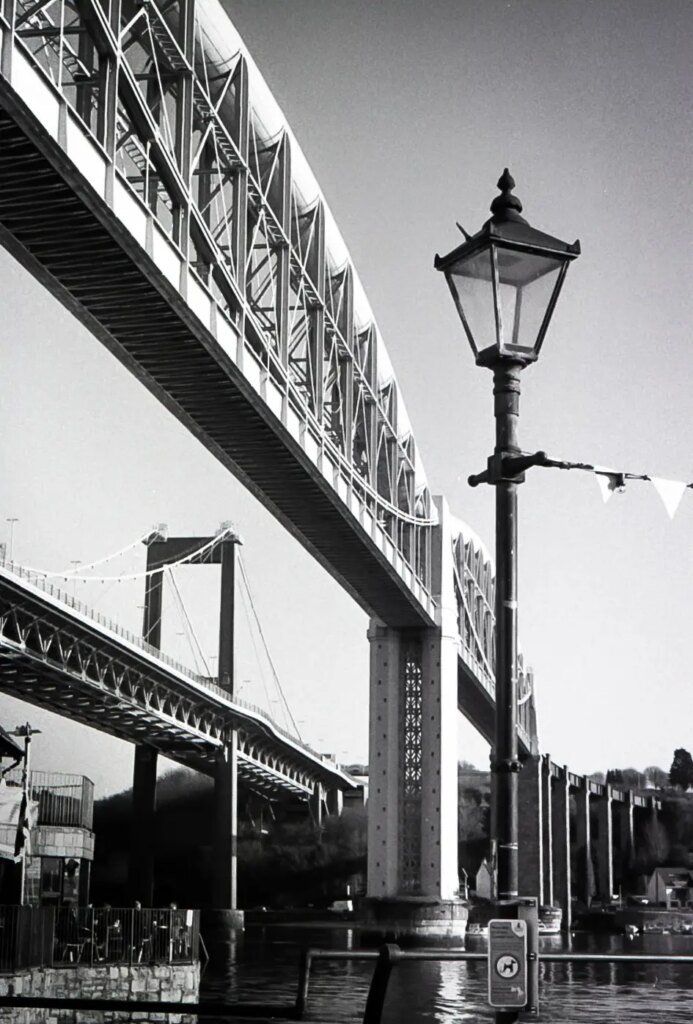
I exposed the film at box speed and developed it in Rodinal at 1+25 which would enhance the grain to some extent, although I didn’t notice any significant graininess when I scanned the negatives and processed them in Lightroom. The Brunel Railway Bridge features heavily in this set of photographs; completed in 1859 it dominates the Saltash river front and remains in use to this day. The Tamar Bridge, in the background, carries road transport and has a pedestrian walkway.
I like using this little camera, which is surprising weighty considering its size and I think that the Canon lens, itself not exactly lightweight, gives surprisingly good results for its vintage. The Leica dates back to the mid to late 1930’s and works as well today as when it came out of the Leitz factory, and the Canon lens, produced around 20 years later is remarkable sharp. Of course, the Leica has its idiosyncrasies such as no film advance lever – you wind the film on via a knurled knob where you would expect a winder to be. Loading film requires you to cut a longer film leader and only the base plate comes off the camera body making the process a bit fiddly; nevertheless, with regular practice you will normally get an additional frame or two over and above the stated frame count.
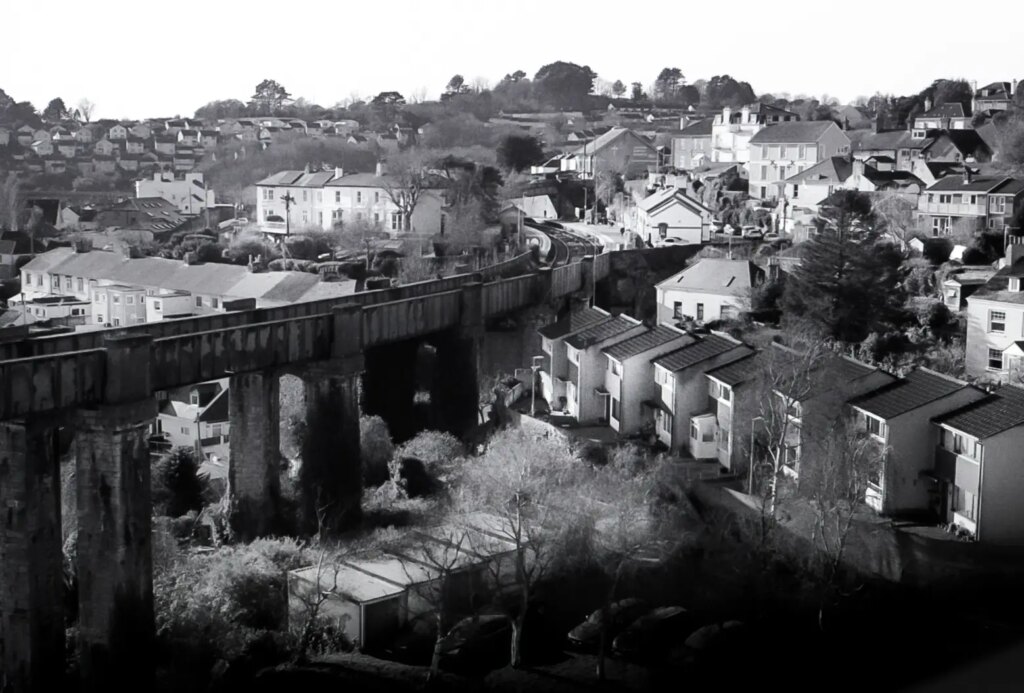
The camera feels good in the hand; its weight gives it stability even though it lacks modern additions such as a grip or motor drive; in use, you can luxuriate in its supreme mechanical reliability and basic good looks. Bringing it up to your eye – one optic to focus and another, quite separate optic to frame, you naturally slow down and take a more considered approach to your photography. Being a rangefinder you can’t be totally sure that what you see in the viewfinder is exactly what will be exposed on the negative, although I rarely need to crop my frames to any great extent. The 50mm lens intrudes on the view also; if you use a lens-hood, it needs to be a ventilated one so that you can see through it; all-in-all, the camera demands attention to detail. Loading film, winding it on and, indeed, winding it off afterwards, is all a bit of a task, but part of the experience of using this piece of history, and the results, in terms of image quality at least, is excellent.
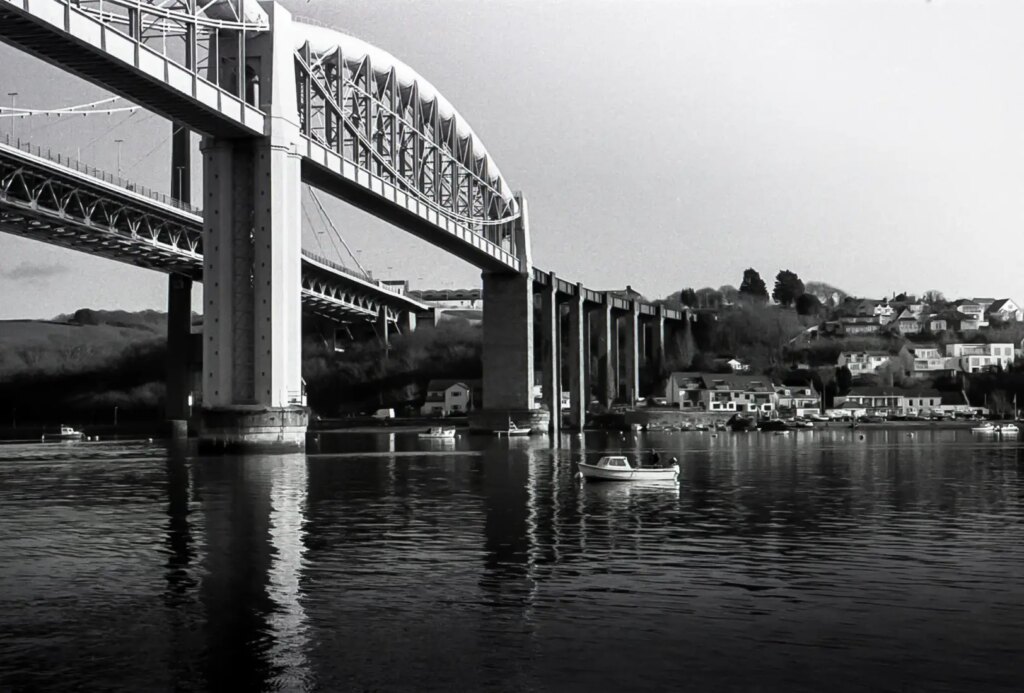
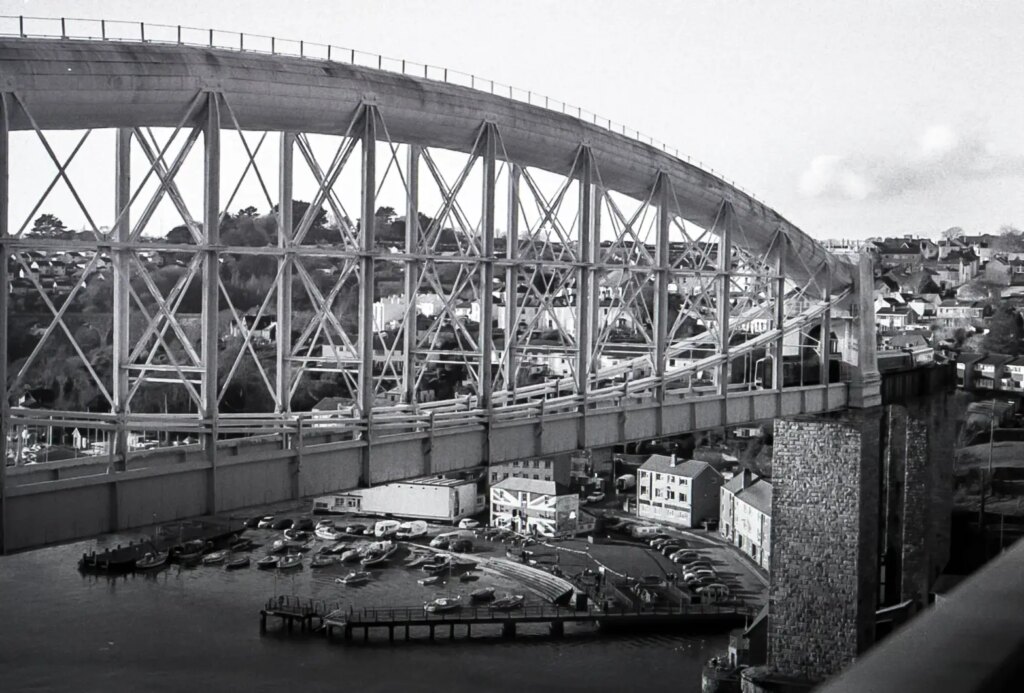
I use all kinds of cameras and formats and have favourites that I go to for different tasks and effects, but if I am simply going for a walk and want to record what I see, the IIIa is definitely one of my favourites. For a camera that is more than 80 years old it remains remarkably good in every way.
Share this post:
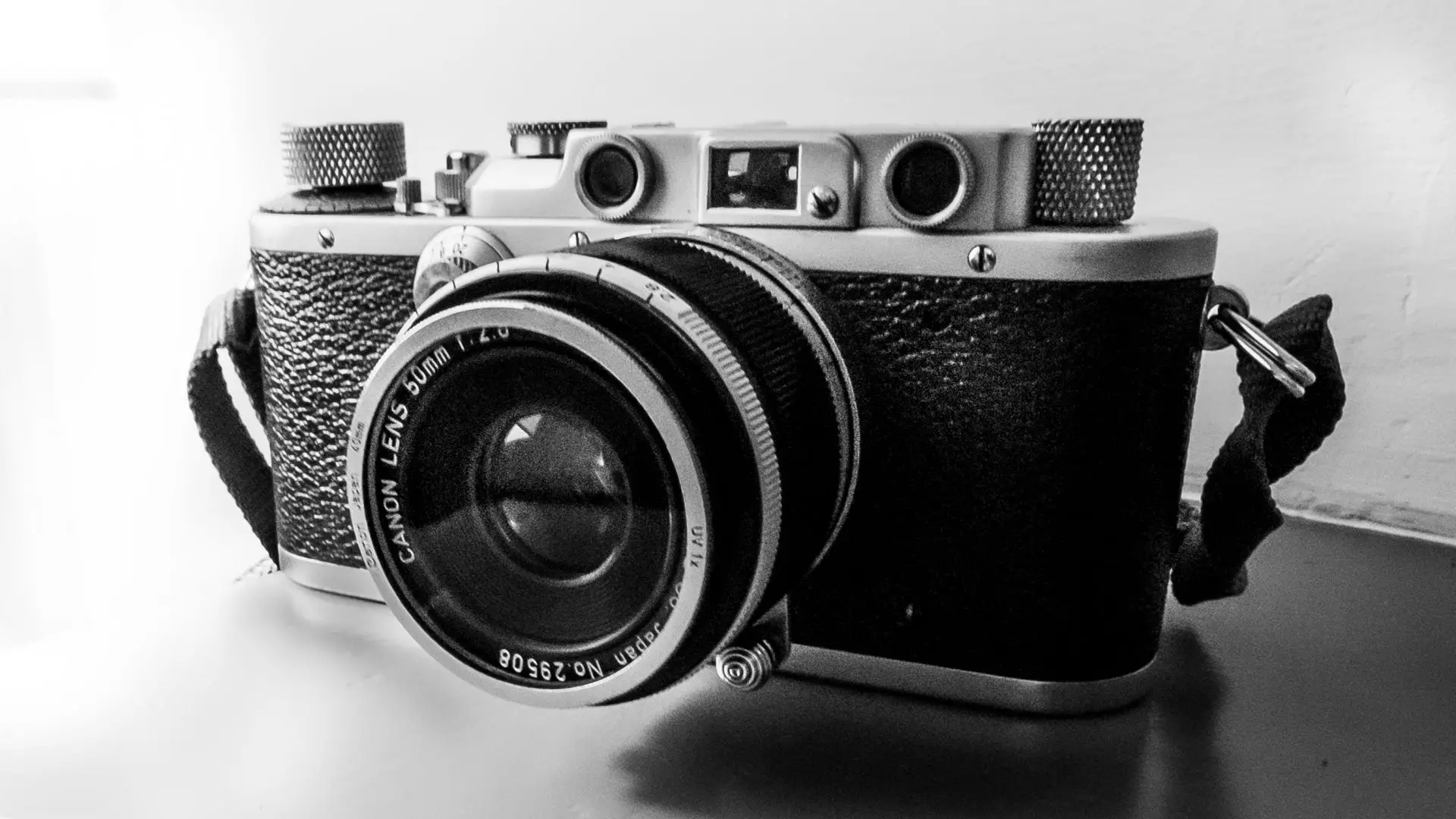








Comments
Martin Siegel on 5 Frames with a Leica IIIa, Canon LTM 50mm f2.8 lens and Kentmere 400 – By Richard de Bulat
Comment posted: 26/02/2023
Thanks for sharing this.
Comment posted: 26/02/2023
Bob Janes on 5 Frames with a Leica IIIa, Canon LTM 50mm f2.8 lens and Kentmere 400 – By Richard de Bulat
Comment posted: 26/02/2023
I rather like Kentmere (and AgfaPhoto APX, which I think is the same stock), which has become my go-to budget film. It behaves itself very well and the negatives dry nice and flat without curl. I also use Rodinal (well actually Foma R09), but generally at the 1:50 dilution.
Comment posted: 26/02/2023
DANIEL J CASTELLI on 5 Frames with a Leica IIIa, Canon LTM 50mm f2.8 lens and Kentmere 400 – By Richard de Bulat
Comment posted: 26/02/2023
A nice set of photos. I remember showing a video on the Brunel Bridge to a pre-engineering class of high school students. They may have nodded off, but I was impressed with the structure.
It's good to practice 'slow' photography as imposed by the mechanical actions of the Barnack Leica's. I like to think of it in terms of 'contemplative' photography. This is much like fly fishing with a bamboo pole.
I use a M2 or M4. To achieve similar results, I bulk load a short roll of film - around 12 exposures, and only carry a couple of rolls.
I recently shot some K400 pushed to EI 800. It was developed in Photographer's Formulary TD-16 (they advertise it as a split D-76.) I was pleasantly surprised at the outcome. I followed Kentmere's suggested dev. time for pushing the film. I may purchase a 100 ft. roll and shoot that for a bit. I like the film.
Peter Kornaukhov on 5 Frames with a Leica IIIa, Canon LTM 50mm f2.8 lens and Kentmere 400 – By Richard de Bulat
Comment posted: 26/02/2023
Comment posted: 26/02/2023
Gil Aegerter on 5 Frames with a Leica IIIa, Canon LTM 50mm f2.8 lens and Kentmere 400 – By Richard de Bulat
Comment posted: 26/02/2023
Comment posted: 26/02/2023
Ibraar Hussain on 5 Frames with a Leica IIIa, Canon LTM 50mm f2.8 lens and Kentmere 400 – By Richard de Bulat
Comment posted: 26/02/2023
Very nice B&W work - really nice compositions and tones!
Do you use a yellow filter ?
Comment posted: 26/02/2023
Richard de Bulat on 5 Frames with a Leica IIIa, Canon LTM 50mm f2.8 lens and Kentmere 400 – By Richard de Bulat
Comment posted: 26/02/2023
Röd White on 5 Frames with a Leica IIIa, Canon LTM 50mm f2.8 lens and Kentmere 400 – By Richard de Bulat
Comment posted: 26/02/2023
Kodachromeguy on 5 Frames with a Leica IIIa, Canon LTM 50mm f2.8 lens and Kentmere 400 – By Richard de Bulat
Comment posted: 27/02/2023
The later versions of the Leitz 5cm ƒ/3.5 lenses were coated and possibly better contrast than the one you tried.
The Canon 50 ƒ/2.8 is an interesting option. I think it is a Tessar-type of lens with 4 elements. Where did you find one that was not fogged, etched, or suffering fungus? Almost all the ones I see on eBay now are close to ruined. Something in the lubricants appears to have ruined many of them as well as the similar-vintage Canon 50mm ƒ/1.8 lens.
Comment posted: 27/02/2023
Kurt Ingham on 5 Frames with a Leica IIIa, Canon LTM 50mm f2.8 lens and Kentmere 400 – By Richard de Bulat
Comment posted: 28/02/2023
Comment posted: 28/02/2023